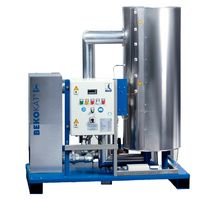Cost Effective Alternatives To Costly Oil Free Compressors Exist
OIL-Free versus Oil-Less
An Oil-Less compressor will have no oil in the compression chamber or compression area. However, they will use oil to lubricate bearings, bushings and gears, etc. An example would be the Aero compressor that utilizes a Quincy QR25 lubricated crankcase, an extension piece between the cylinders and crankcase. The extension piece houses connecting rods, a cross head, and piston rods with a wiper between the piston rods and the piston.
An Oil-Free compressor will have no oil in the compressor. Rotors will be direct drive with no gear box. Sealed permanent lubricated bearings are used throughout.
Units with no oil operate at a much higher temperature. Higher operating temperatures cause abbreviated bearing service life . Expanded tolerances in the air end (or element as some manufacturers call them) result in much lower efficiency and higher electrical costs. The usual answer is a second air end. This solution requires the interconnecting piping, and an inter stage (intercooler) cooler. All these additional components add to the initial purchase price as well as additional maintenance and repair costs.
In the instance oil-free air is specified either by the client or by regulation, there are alternatives.
Cost Effective Alternative
While filtering is an alternative it will by no means supply totally hydrocarbon free air. In addition, filters used in this manner require a frequent maintenance cycle.
The ONLY way to assure hydrocarbon-free air is to either use a compressor that ads no hydrocarbons to the air stream or utilize a device that will break down hydrocarbons to their molecular components. Several manufacturers sell devices that use heat and catalysts to separate hydrocarbons into water and carbon dioxide. A simple refrigerated dryer removes water. Carbon dioxide vents to atmosphere.
These devices are available in several capacities. Whether sized to handle the total output of an air compressor or sized to handle only the amount of air required in a specific area, such as a lab, or the branch to a specific process, this is a much more economical method of achieving hydrocarbon-free compressed air.
Keep in mind that in the case of a branch, the area will not be part of the “loop” system that is the ideal design for a compressed air distribution system.

